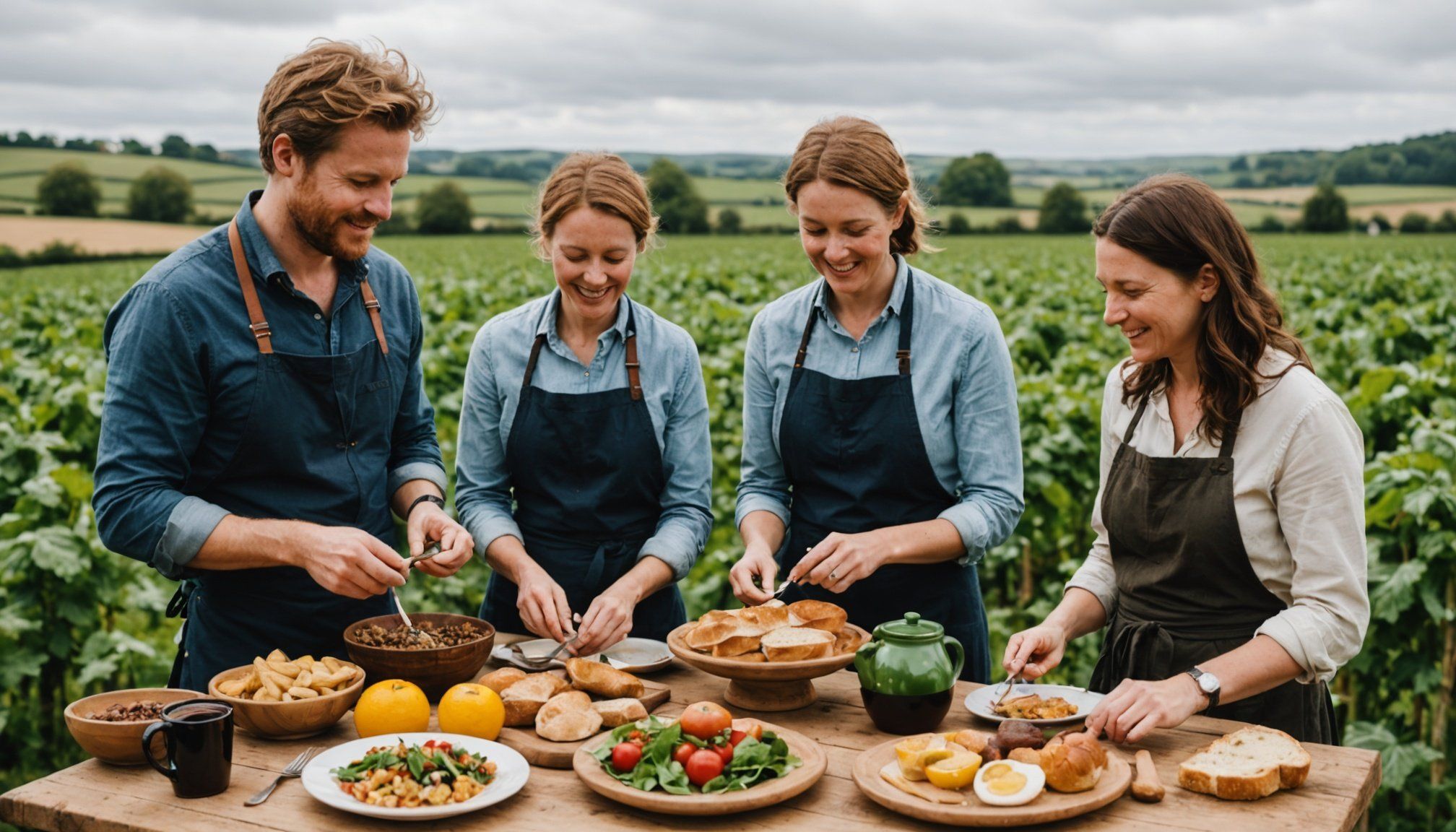Unleashing the Power of Storytelling: How Artisanal Food Producers in the UK Create Unique Brand Narratives
In the bustling world of artisanal food production in the United Kingdom, one element stands out as a crucial factor in the success of these businesses: storytelling. Effective brand storytelling is not just a marketing tactic; it is a powerful tool that connects people, builds loyalty, and elevates brands to new heights. Here, we delve into the world of artisanal food producers and explore how they harness the power of storytelling to create unique and compelling brand narratives.
The Anatomy of Great Brand Storytelling
When it comes to brand storytelling, artisanal food producers in the UK understand that it is not just about selling a product, but about sharing a story that resonates with their audience. A workshop hosted by Tastebuds Collective and led by Amy and Becky from Pier, a marketing and PR agency, highlighted several key components of successful brand storytelling[1].
Also to read : Proven Strategies Every UK Financial Advisor Should Use to Steer Client Portfolios Through a Bear Market
Identify Your Core Ingredients
The foundation of any great story is its core ingredients. For food and drink businesses, these ingredients often include the history of the brand, the passion behind the products, and the people involved in the process. Artisanal producers need to balance facts with emotion, ensuring that their stories are authentic and relatable. As Amy and Becky emphasized, people tend to make buying decisions based on feelings first and facts second.
Map Out Your Journey
Every brand has a unique journey that can captivate its audience. This involves identifying pivotal moments in the brand’s history, such as the inspiration behind the first recipe or the challenges overcome during product development. By sharing these stories, brands can help customers appreciate their history and understand why they should choose their products over others.
Topic to read : Innovative Approaches for UK Healthcare Providers to Seamlessly Incorporate AI in Diagnostics
Humanise Your Brand
Audiences relate to stories that feel genuine and personal. Artisanal food producers often humanise their brands by showcasing the people behind the products. This can include sharing behind-the-scenes content, highlighting both the successes and the challenges, and engaging with customers on social media. For example, Caliendo’s Gelato, with its deep family roots in artisanal Italian gelato, emphasizes the passion and artistry behind each scoop, creating a strong emotional connection with their customers[5].
Show and Tell
In today’s digital age, visuals play a critical role in storytelling. Artisanal food producers need to complement their stories with engaging visuals that align with their brand’s tone and aesthetic. This includes high-quality food photography, consistent branding across all platforms, and creative video content. Kimberly Espinel’s book, “How to Make Your Food Famous,” provides practical advice on mastering lighting and creating a consistent aesthetic, which is essential for making a brand’s story visually appealing[2].
The Role of Social Media in Brand Storytelling
Social media platforms are indispensable tools for artisanal food producers looking to tell their stories and connect with their audience. Here are some ways social media can elevate brand storytelling:
Visual Storytelling
High-quality visuals of food products can entice potential customers and foster a sense of community. For instance, George’s Bakery, which started as a market stall in St. Ives, Cambridgeshire, and is now a national brand, uses humour and behind-the-scenes content to engage its audience on TikTok, amassing over 450,000 followers and 7.3 million likes[2].
Interactive Content
Interactive content, such as videos, reels, and live streams, can create a sense of engagement and encourage repeat business. Flouring Kitchen, a Canadian brand, uses simple and creative dessert recipes to resonate with its audience, illustrating how interactive content can build a loyal community[2].
User-Generated Content
Encouraging user-generated content is another powerful way to involve the audience in the brand’s story. By sharing customer feedback and user-generated content, brands can create a sense of belonging and community. As Charlotte Beach from Tastebuds Collective noted, “Encouraging interaction and being responsive to feedback should always remain at the top of your priority list”[1].
Case Studies: Successful Brand Storytelling in Action
Here are a few case studies that illustrate how artisanal food producers in the UK have successfully harnessed the power of storytelling:
Caliendo’s Gelato
Caliendo’s Gelato is a prime example of a brand that has woven its family history and artisanal methods into a compelling narrative. By honoring the rich heritage of gelato-making and emphasizing sustainable practices, Caliendo’s creates a meaningful experience for its customers. Their story is not just about selling gelato; it is about sharing a tradition that connects people to their community and their heritage[5].
George’s Bakery
George’s Bakery transformed from a local market stall to a national brand through effective storytelling. By using humour, behind-the-scenes content, and engaging visuals, George Hepher has built a massive following on social media. His story is a testament to how authenticity and creativity can resonate with audiences and drive business growth[2].
Trends in Food and Drink Storytelling for 2025
As we look ahead to 2025, several trends are expected to shape the way artisanal food producers tell their stories:
Sustainable Practices
Sustainability is becoming a prerequisite for innovation in the food and drink industry. Over 60% of consumers are trying to adopt more planet-positive habits, and brands are responding by focusing on ethical sourcing, reducing carbon footprints, and championing social and environmental causes. Artisanal producers who incorporate sustainable practices into their stories can build trust and loyalty with their audience[3].
International Snacking
Consumers are increasingly looking for global flavours in their snacks. Artisanal food producers can tell their snack story by sharing their cultural roots and nostalgic childhood food memories. This trend offers a unique opportunity for brands to create fusion foods that have mass appeal and tell a story of cultural exchange and innovation[3].
Mindful Indulgence
The trend of mindful indulgence, where treats balance flavour and quality ingredients with personal values like sustainability and health-consciousness, is on the rise. Brands that tell stories of how their products deliver pure enjoyment while aligning with consumer values can resonate deeply with their audience. For example, premium single-serve cakes and hot chocolate are becoming popular treats that offer a guilt-free indulgence experience[3].
Practical Insights and Actionable Advice
For artisanal food producers looking to elevate their brand through storytelling, here are some practical insights and actionable advice:
Develop a Consistent Brand Message
Ensure that your brand message is consistent across all platforms. This includes your website, social media, packaging, and any other touchpoints with your audience.
Use High-Quality Visuals
Invest in high-quality food photography and video production. Visual storytelling can make or break your brand’s appeal, especially on social media.
Engage with Your Audience
Encourage interaction and be responsive to feedback. User-generated content can be a powerful tool in building a loyal community.
Align with Consumer Trends
Stay informed about consumer trends and adjust your storytelling accordingly. For instance, incorporating sustainable practices or mindful indulgence into your narrative can make your brand more appealing.
Table: Key Components of Effective Brand Storytelling
| Component | Description | Example |
|---|---|---|
| Core Ingredients | Balance facts with emotion, highlight authenticity and relatability | Caliendo’s Gelato emphasizing family history and artisanal methods[5] |
| Brand Journey | Share pivotal moments in the brand’s history | George’s Bakery sharing its journey from a market stall to a national brand[2] |
| Humanisation | Showcase the people behind the products | Behind-the-scenes content on social media[1] |
| Visual Storytelling | Use high-quality visuals that align with the brand’s tone and aesthetic | High-quality food photography and video content[2] |
| Interactive Content | Create engaging videos, reels, and live streams | Flouring Kitchen’s simple and creative dessert recipes[2] |
| User-Generated Content | Encourage and share customer feedback and content | Sharing customer reviews and photos on social media[1] |
Quotes from Industry Experts
- “Tastebuds is so incredibly lucky and thankful to have a brilliant network of experts, including Becky and Amy, to ensure our food and drink businesses receive the most up to date advice and guidance in all fields.” – Charlotte Beach, Events and Marketing Manager, Tastebuds Collective[1]
- “If you, like me, have ever scrolled through recipes on Instagram and thought, ‘Uh, how did they get that perfect shot?’, Kimberly has the answer. This book unveils essential strategies for standing out in the crowded world of food content creation, with insights from influencers boasting massive followings.” – Yotam Ottolenghi[2]
- “Understanding the art of storytelling is key to opening up new creative avenues, and we can’t wait to see what our attendees do next.” – Becky Whiting, Senior Account Director, Pier[1]
In the competitive world of artisanal food production, storytelling is more than just a marketing tool; it is a way to connect with people, build loyalty, and elevate brands. By identifying their core ingredients, mapping out their journey, humanising their brand, using visual storytelling, and engaging with their audience, artisanal food producers in the UK can create unique and compelling brand narratives. As we move into 2025, staying aligned with consumer trends such as sustainability, international snacking, and mindful indulgence will be crucial. With the right approach to storytelling, these producers can not only survive but thrive in a crowded market.











